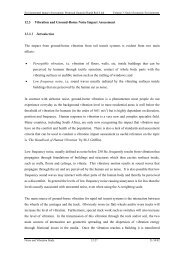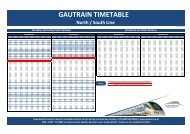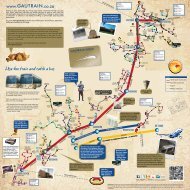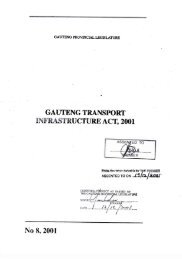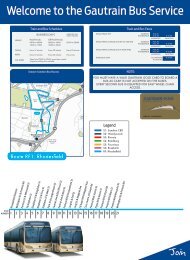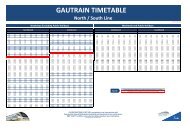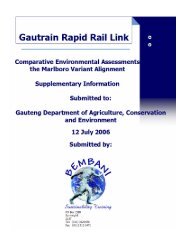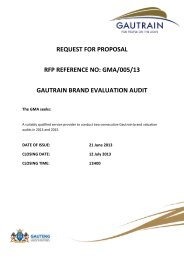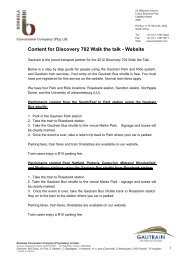Gauteng SDI Rail Link - Gautrain
Gauteng SDI Rail Link - Gautrain
Gauteng SDI Rail Link - Gautrain
- No tags were found...
You also want an ePaper? Increase the reach of your titles
YUMPU automatically turns print PDFs into web optimized ePapers that Google loves.
ivcosts may result in problems. Life-cycle costs and economies of scale will to a largeextent determine the appropriate approach. Train speeds of approximately 180 km/hor slightly higher seems to be applicable to the anticipated type of service and typeof train to be used. The term "high speed" is therefore not appropriate. A newunique image is necessary to maximise patronage, which will influence the type ofequipment and service. It seems most probable that new railway lines will berequired for the whole or most of the new route or network.Alternative Route Alignments and Station LocationsThe proposed methodology for network and route alignment provides theidentification and evaluation of approximately two to five alternatives. One or twofinal networks will be proposed by the end of August 2000 as a basis for moredetailed planning. The following are some of the important aspects in theroute/network determination:• The broad corridor between Pretoria and Johannesburg will most probably haveas western boundary the Ben Schoeman N1 Freeway and as eastern boundarythe existing railway line. Where possible existing road and rail corridors will beutilised.• The possibility of accommodating multiple type services on the main line will beinvestigated.• The Airports Company of South Africa will be consulted as to how the <strong>SDI</strong> <strong>Rail</strong><strong>Link</strong> can be integrated with the development of the Johannesburg InternationalAirport.Station Development Concepts and Surrounding Land UseThe location and development of stations is one of the most important aspects in theplanning of the routes and networks. Station location would primarily be determinedby existing development, or committed new development. Local authorities wouldhave to be fully involved in the location of stations and the development concept at,and surrounding the stations. Matters such as the rezoning of land, bulk servicecontributions and the legal implications for government involvement will beinvestigated, as well as the value-capture potential of the stations.Although it will not directly affect the bankability of the project, the policy on land usein the areas surrounding stations is important for the longer-term success of theproject. Densification at nodes and corridors is essential for the feasibility of publictransport projects.Feeder and Distribution SystemsPrimary public transport feeder/distribution systems should be dedicated andgenerally of a higher quality than most of the existing public transport services. The<strong>Rail</strong> <strong>Link</strong> must be able to control or significantly influence operational decisions ofsuch services. Mechanisms should be pursued to bring certain taxi operators into theintegrated feeder/distribution system. Attention should also be paid to restructureexisting bus and rail transport services to support this project.<strong>Gauteng</strong> <strong>SDI</strong> <strong>Rail</strong> <strong>Link</strong> – Inception Report, 15 June 2000



